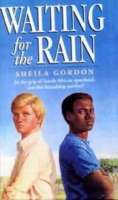
In this adaptation of the traditional folktale, three little dassies (also called rock hyraxes) build their houses in the Namib Desert of Southern Africa, hoping for protection from the eagle that lives atop a nearby mountain.
Materials from South Africa

In this adaptation of the traditional folktale, three little dassies (also called rock hyraxes) build their houses in the Namib Desert of Southern Africa, hoping for protection from the eagle that lives atop a nearby mountain.
With the help of a blue crane, a mother dove rescues her babies from a not-so-clever jackal.
Khoikhoi, Southern Africa

When the village girls cruelly trick the daughter of their king, he will forgive them only if they kill Nabulela, a treacherous white-skinned monster. A tale of the Nguni people

Wishing to make beautiful music with the flute that was given to her by her mother, young Lindiwe captures the songs of six different birds in her flute and shares the irresistible tune with the people of her African village.

Rabbit tricks the other animals of the African plain into giving her food and other treats.

The sly seductive moon makes off with a crying baby but is eventually outwitted by the clever Mr. Fez.

Tengo is the 10-year-old son of workers on Oom Koos’s large farm in the Transvaal. He longs to go to school like his friend Frikkie, who visits his uncle’s farm on holidays. But Tengo’s family is too poor to pay for the education that comes free to whites. He finally gets his wish at age 14. Tengo goes to live with his cousin in a squalid township outside Johannesburg and studies furiously. After three years, he is almost ready for college, but a year-long school boycott ruins his chances and he is drawn into the fight against apartheid. When he and Frikkie meet in a violent confrontation, Tengo realizes that he will carry on the struggle for freedom as a scholar, not a soldier. The writing here is powerful, evoking in minute detail daily life and the broad landscapes of the country.

The Boer War was disastrous for the British: 22,000 of them died. Close to 7,000 Boers died. Nobody knows how many Africans lost their lives, but the number is estimated to be around 20,000. This tragic, and little remembered, chapter in history is the backdrop for Trilby Kent’s powerful novel. Corlie Roux’s father has always told her that God gave Africa to the Boers. Her life growing up on a farm in South Africa is not easy: it is beautiful, but it is also a harsh place where the heat can be so intense that the very raindrops sizzle. When her beloved father dies, she is left in the care of a cold, stern mother who clearly favors her two younger brothers. But she finds solace with her African maitie, Sipho, and in Africa itself. Corlie’s world is about to vanish: the British are invading and driving Boers from their farms. The families who do not surrender escape in the bush to help fight off the British. When Corlie’s laager is discovered, she and the others are sent to an internment camp. Corlie is strong and can draw on her knowledge of the land she loves, but is that enough to help her survive the starvation, disease, and loss that befalls her in the camp?
See the review at WOW Review, Volume 5, Issue 2

Khosi lives with her beloved grandmother Gogo, her little sister Zi, and her weekend mother in a matchbox house on the outskirts of Pietermaritzburg, South Africa. In that shantytown, it seems like somebody is dying all the time. Billboards everywhere warn of the disease of the day. Her Gogo goes to a traditional healer when there is trouble, but her mother, who works in another city and is wasting away before their eyes, refuses even to go to the doctor. She is afraid and Khosi doesn’t know what it is that makes the blood come up from her choking lungs. Witchcraft? A curse? AIDS? Can Khosi take her to the doctor? Gogo asks. No, says Mama, Khosi must stay in school. Only education will save Khosi and Zi from the poverty and ignorance of the old Zulu ways.School, though, is not bad. There is a boy her own age there, Little Man Ncobo, and she loves the color of his skin, so much darker than her own, and his blue-black lips, but he mocks her when a witch’s curse, her mother’s wasting sorrow, and a neighbor’s accusations send her and Gogo scrambling off to the sangoma’s hut in search of a healing potion.J.L. Powers holds an MA in African history from State University of New York-Albany and Stanford University. She won a Fulbright-Hays grant to study Zulu in South Africa, and served as a visiting scholar in Stanford’s African Studies Department. This is her second novel for young adults.
See the review at WOW Review, Volume 5, Issue 2 and Volume XI, Issue 3.

In 2200, Rain, a young princess of the River People, and her lion cub Saa are kidnapped in an attempt to gain the River Peoples’ secret of harvesting the rain and to force Rain’s participation in a terrible ceremony.